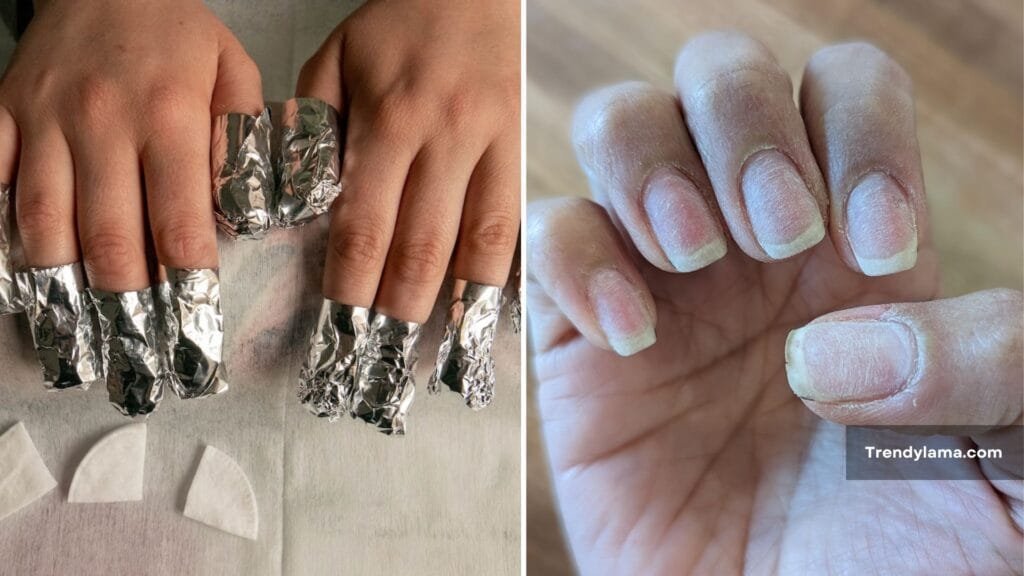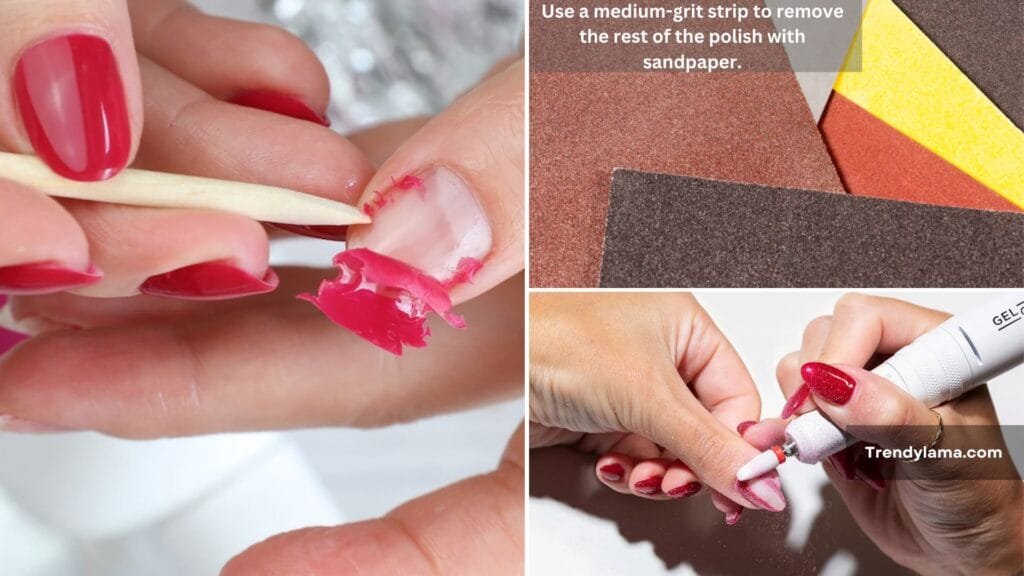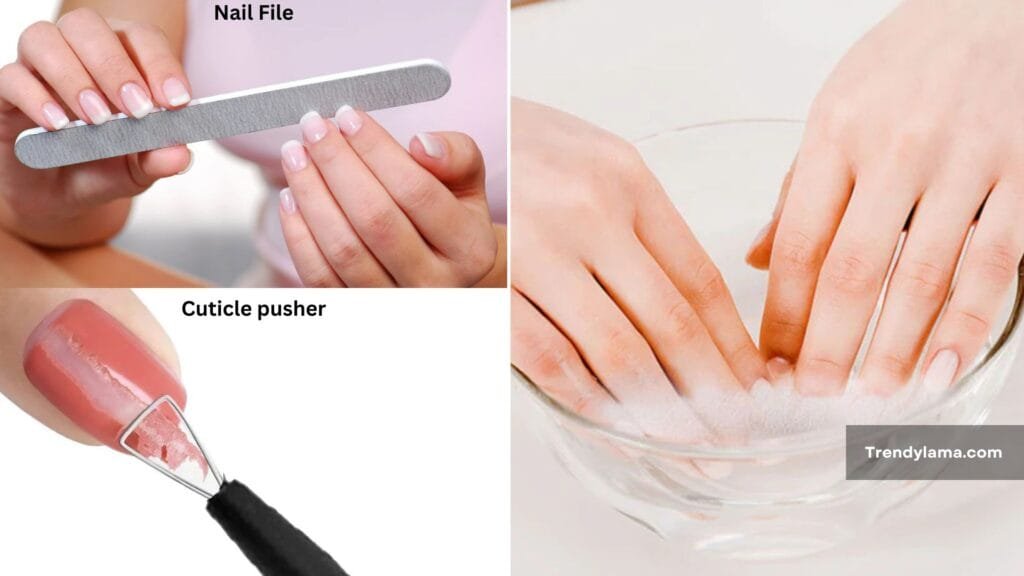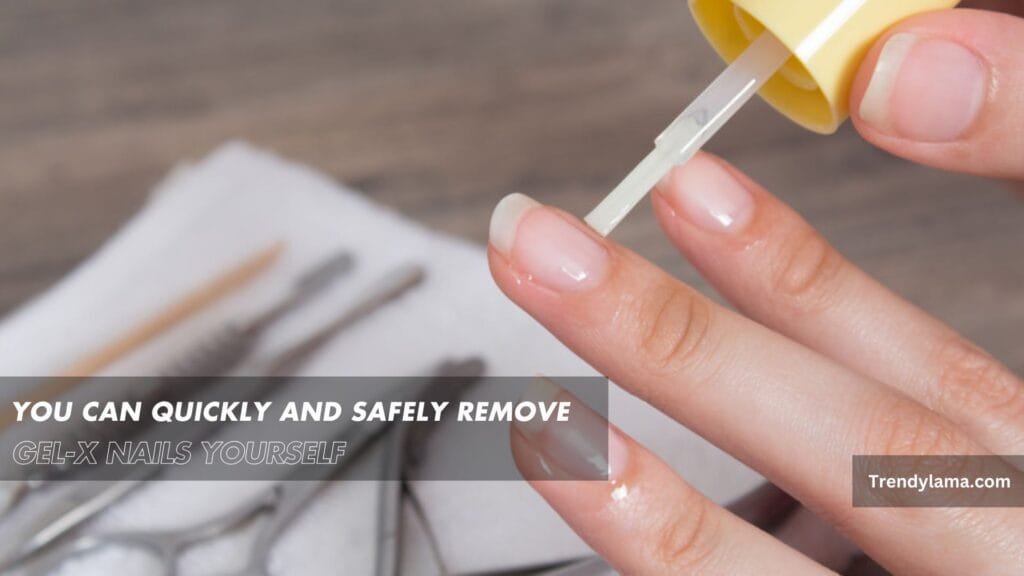Gel-X nails are a beautiful, long-lasting, and safe alternative to acrylic nails, but they can damage your nail plate if you don’t remove them properly. Luckily, we’re here to help! We’ve got the best ways to remove the gel layer and reveal your natural nails, plus how to moisturize and nourish them to prevent damage. We’ll also cover whether your gel-X nails will fall off on their own, and what to do if they start to lift. Keep reading for more!
The Best Method to Remove Aprés Gel-X Nails
Remove the top coat with a nail file. Clip extensions to the length of the nails. Then, put a cotton ball soaked in acetone onto each nail. Wrap each nail in aluminum foil to hold the cotton balls in place for 20 minutes. Remove the gel-X nails with a cuticle pusher and scrape it off. Remove the residue with a nail file.
Removing Gel-X Nails with Acetone and a Nail File
File off the top coat and trim the tips of the nails.
Gently and evenly slide a 180-grit nail file up and down each nail to remove any designs and clear coat. Trim the tips with a nail clipper or basic nail clippers.
- Try not to file too close to the nail plate or cuticle. Your goal is to remove the clear coat so the acetone can reach the polish and glue underneath.
- When you’re done, apply a thin layer of petroleum jelly around each cuticle to protect your skin from the acetone.

Wrap your nails with acetone-soaked cotton balls and aluminium foil.
Soak a cotton ball in 100% pure acetone and place it on your nail. Cut a 3-by-3-inch (7.6 by 7.6 cm) piece of aluminium foil and wrap it around your nail to hold the cotton ball in place and prevent the acetone from evaporating. Repeat for each nail. Leave the foil on for around 15 to 20 minutes.
- You can also use nail polish remover clips instead of aluminum foil. Simply unroll the clip and slide it over your finger and the acetone-soaked cotton ball.
- Or use a rolled or folded paper towel soaked in acetone.
- If you don’t have any of these supplies on hand, soak your fingers in a small bowl of acetone for 5 minutes. Soak longer if necessary to remove all the gel-X nails.
- Wrap your nails in hot towels while they are wrapped in aluminum foil to speed up the gel-X nails removal process.
Wait 15-20 minutes, then remove the foil and scrape off the excess gel-X nails.
After 15 to 20 minutes, remove your foil also and the cotton very carefully. Using an cuticle pusher remove any remaining gel-X nails. Other jewels should be removed using the polishing file of 180 grit.
- If you don’t have a cuticle pusher, try buffing the gel-X nails with a paper towel soaked in acetone or smoothing it out with a nail file.
Removing Gel-X Nails Using an E-File
File the tips of your nails and remove the polish.
Use a regular nail clipper or nail file to trim the length of your nails and make them easier to remove. If your nails have polish on them, try gently removing it with a pair of nippers or a cuticle pusher.
- If your nail polish doesn’t come off easily, just trim the tip and move on to the next step.

Run an electric file over your nail until most of the polish is gone.
Attach a coarse safety bit to your electric file and set it to 20,000 RPM. Turn on the electric file and carefully float it over the polish on your nail plate, moving from the cuticle down to remove the paint.
- Do not press the electric file against your nail. Instead, imagine that you are trying to remove nail polish from an egg—you don’t want to press so hard that you break the surface.
- Use a cuticle ball to remove the polish close to the cuticle of your nails
Use a medium-grit strip to remove the rest of the polish with sandpaper.
Attach a medium-grit strip to the mandrel of your electric file and set the speed to 8,000 RPM. Gently slide the file from the cuticle down to the tip of the nail, removing as much polish and glue as possible. Be careful to move close to the cuticle to avoid damaging it.
If you have acetone available, soak a cotton ball in it and gently rub the surface of your nails to make sure all the glue and polish are removed.
Removal of Gel-X Nails with soap and water, as well as oil
Soak your nails in a bowl with warm water, dish soap, and frying oil.
Fill a medium bowl (or two small bowls) with warm water and add a drop or two of regular dish soap and about 2 tablespoons (30 ml) of cooking oil. Mix the solution and soak your nails in water for around 10 minutes.
- If you have acetone on hand, mix about 1 US tablespoon (15 ml) into the mixture before soaking.
- Hard gel (or builder gel) cannot be soaked off—it can only be removed. However, Gel-X nails are made of soft gel, which means they can be soaked off with either acetone or water.

Use a cuticle pusher to remove gel nails.
Dry your hands with a towel and use a cuticle pusher to carefully remove the end of the artificial nail from your natural nail. While lifting the gel, push from the bottom edge of the nail near the cuticle towards the end of the nail.
- If the nail does not come off easily, soak it in water for another 10 minutes and then try to remove it again to avoid damaging your natural nail.
- If you do not have a cuticle pusher, try using another artificial nail or an orange stick.
Using a nail file, remove any additional glue.
To remove any residual adhesive from your natural nail, use a standard nail file or buffer. After removing all of the adhesive, wash your hands with soap and water. Use cuticle oil on your nails and cuticles.
- If you don’t have cuticle oil, use jojoba or coconut oil instead.
Repairing Your Nails After Gel-X Nail Removal
Gently file your nails and moisturize with cuticle oil.
Use a multi-purpose nail buffer to smooth the top of your nail, smooth the surface, and remove any remaining gel. Massage cuticle oil into each nail and the surrounding area to feed and moisturize your natural nails.
- Alternatively, try using jojoba oil, which can moisturize your nails and skin and help prevent moisture loss.
- After you’ve removed your nails, try not to polish them for a few days to allow your natural nails to heal.
Professional removal of Gel-X nails
If you are not comfortable removing your nails, visit a nail salon.
If your nails are brittle, or if you have difficulty removing the Gel X layer with DIY methods, it is best to consult a professional. Nail technicians are trained to safely and effectively remove gel manicures without damaging your natural nails.
- Gel manicure removal usually costs between $10 and $20.
Do gel-X nails fall off on themselves?
Gel manicures usually lift off your natural nail after 2 to 3 weeks.
Gel nails will eventually start to lift off your nail plate, especially near the cuticle. However, once your nails start to lift, it’s best not to pick or remove the rest of them. This can remove the top layer of your natural nails, leaving them dry, rough, and brittle.
- Nail artist Mia Ruby says gel manicures can make your nails brittle if you “remove your gel or peel it off and then remove layers of the nail…”
- If you notice your nail starting to peel, try one of the methods above to remove it or see a professional to repair it.
- Apply cuticle oil to your natural nails daily to prevent them from separating from your gel nails.
Are Gel-X nails safer than acrylic nails?
Gel X manicures are safer for your nails than acrylics.
While gel nails like Gel X can cause your natural nails to chip or become brittle, they are more flexible than acrylic nails. This means that gel nails are less likely to crack your natural nails. However, using acetone to remove them without repairing your nails afterward can also cause damage.
- Gel nails also don’t require much drilling to remove.
- Gel nails are applied with a gel (not glue) and filed to the desired shape, while acrylic nails require acrylic monomer/liquid or acrylic powder.
Frequently Asked Questions
At BeautyGARDE, we strongly recommend that you avoid any type of artificial nails. While they may look pretty, and nail art may look great for certain occasions, you are putting yourself at risk for serious damage to your nails, including infection, split nails, etc.
No, “regular” nail lacquer forms a barrier, preventing the Rocket Nail Fuel from operating. Fortunately, you can get the Rocket Nail Fuel System, which includes:
- Rocket Nail Fuel
- Nail color of your choice
- Cuticle oil
- Nail Fuel remover







